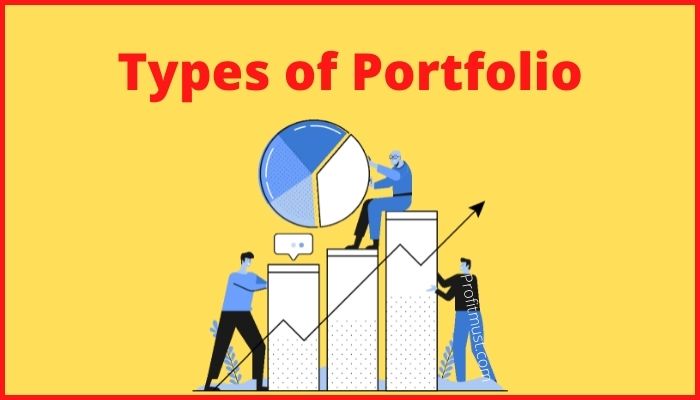The purpose of portfolio management is to optimise overall portfolio returns rather than just the profits from one or two stocks. However, in order to do so, you must first understand the different types of portfolios. Let’s look at what an investment portfolio is and the different types of portfolio.
Table of Contents
What is an Investment Portfolio?
An investor’s investment portfolio is a combination of securities that he or she owns. Bonds, equities, mutual funds, pension plans, real estate, and even tangible assets including gold can be included in this portfolio (coins or bars).
In a nutshell, this refers to any asset that has the potential to increase in value or generate income. Many people even invest in unique objects in the hopes of making money in the future.
A well-balanced portfolio includes a variety of investments. Government bonds, small-cap stocks, and FX currencies are all examples of this.
However, it is essential to properly monitor your portfolio. You might wind up with smaller returns if you don’t.
Types of Portfolio
The following is a list of common portfolio types. Nevertheless, Keep in mind that one portfolio style may not be able to support all of your financial requirements. You may need to combine and pair several types of portfolio assets to achieve the right Portfolio for you.

-
Aggressive Portfolio
An aggressive portfolio seeks for larger returns and often takes on higher risks in order to reach this goal. It typically includes a number of high-beta stocks.
When compared to the broader market, these stocks have more volatility. Consider a stock with a high beta of more than 1.5 or 2.0.
They will move higher or lower approximately twice as fast as the market, potentially doubling your earnings or losses.
When it comes to stocks or assets, aggressive investors aren’t always looking for household brands.
They frequently pick businesses that are still in the early stages of development and have a unique value proposition that can generate exceptional returns for the risks involved.
Advice
If you want to develop a portfolio like this, it’s a good idea to focus on industries like technology, which have a lot of upside potential. However, it would be ideal if you used your logic here as well. Assure that your losses do not outnumber your profits while seeking for the best returns.
-
Defensive Portfolio
A defensive portfolio, on the other hand, does not include equities with a high beta value. Such stocks are usually untouched by market fluctuations.
These equities are relatively safe to invest in since they provide little risk. They don’t generate lavish returns during upswings or fall too hard during business cycle lows.
Businesses that make basic needs or daily needs goods like food and utilities, for example, are likely to weather the storm even in times of economic crisis because client demand stays high.
Advice
In a defensive portfolio, deciding on which assets to invest in is rather simple. Consider the goods that you absolutely require during the day and invest in the company who produces them.
For risk-averse investors, a defensive portfolio is a secure investment.
-
Income Portfolio
Dividends and other regular rewards to shareholders are the focus of an income portfolio. Though it shares many characteristics with a conservative portfolio, one key distinction is that it invests in equities with higher yields.
Real estate is a fantastic example of this. It offers a greater profit share in exchange for favourable tax advantages.
One bonus of investing in real estate stocks is that you can reap all of the benefits of investing in such a big market without having to worry about property ownership.
Nevertheless, real estate is not extremely resilient during economic downturns, which is a disadvantage.
Advice
If you want to develop this type of portfolio, seek for stocks that aren’t as well-known but pay out decent dividends. You can also look at FMCG, utilities, and other reliable businesses to invest in.
This is a fantastic option if you want your portfolio to work as an active supplement to your monthly paycheck or as a source of income throughout your retirement years.
-
Speculative Portfolio
A speculative portfolio demands a high level of risk tolerance, to the point where it is frequently compared to gambling. The portfolio is not only aggressive in this case, but it is also betting on which product or service offering will perform well in the future.
Initial Public Offerings (IPOs) and takeover targets are good candidates for a speculative portfolio. This category also includes technology and health-care companies that are focused on cutting-edge research or breakthrough insights.
Advice
Not every investor is willing to take such a big risk. Speculative assets in a portfolio should be limited to 10% or less, according to financial experts.
Furthermore, first-time investors must make an informed decision. To know which business you can trust to generate exceptional profits, you’ll need a lot of research and experience.
-
Hybrid Portfolio
Last in our list of types of portfolio is Hybrid portfolio. As the name implies, such a portfolio requires you to invest in a mix of asset types with different fundamentals in order to get the best of both growth and dividend-paying investments.
A portfolio like this offers the most flexibility. A hybrid portfolio is made up of a mix of high-yielding stocks and fixed-income investments like debt funds and bonds.
Advice
This strategy provides diversification across a variety of asset groups. This is advantageous in and of itself because historically, stocks and fixed income assets have had a negative connection.
How to build a Portfolio?
After checking out types of Portfolio, Let’s understand how to build a Portfolio. Portfolio management is all about choosing the correct mix of assets to reduce investment losses while increasing returns.
But keep in mind that this isn’t a one-time thing. In other words, putting together a portfolio of assets isn’t the end of the process.
You must keep an eye on your portfolio at all times. This is to ensure that each investment receives the highest possible profits within the time limit specified.

Example of Types of Portfolio Investment
Let’s take a look at an example. At the start of the year, the 32-year-old CA made an investment in a Heromotocorp stock.
He predicted the stock would return at least 15% over the next seven months, based on his study and market data analysis.
However, as time went on, he saw that the stock had not performed as he had anticipated. The profits were far less than he had expected.
As a result, he made the decision to reconsider his investment. He decided that it was best to get rid of this share from his portfolio and put the money into a better investment.
Things to keep in mind while building a portfolio
Here are the major points which you need to consider while doing types of portfolio management:
-
Diversification
When investing in the share market, it’s a smart idea to diversify your holdings across different market segments. This manner, even if one or two market sectors have a slump, your entire portfolio is not harmed.
-
Reducing cost of Investment
Commission fees and management costs are significant expenses for investors. This is especially important if you frequently purchase and sell stocks. Try using a discount brokerage business to make your investment. Clients are charged much lesser fees by these firms.
Also, when investing for the long run, it is advisable to avoid making judgments based on short-term market fluctuations. To put it another way, don’t sell your stocks just because they’ve taken a minor downturn in the near term.
-
Investment on Regular intervals
It is essential to invest on a regular basis in order to build your portfolio. This will not only help you build wealth over time, but it will also help you develop the habit of investing discipline.
You might also strive to raise the amount you invest as your income rises.
-
Followup Buying
It’s possible that you have no idea how a new stock will perform when you buy it. To be on the safe side, avoid putting your entire position to a single investment. Instead, consider investing in a follow-up approach.
To put it another way, start with a small investment in the stock. If the stock’s performance fulfils your expectations, you can gradually increase your investments until you’ve covered your entire position.

Conclusion
Take the time to learn about the fundamentals of each asset class and determine the best balance of investments to hold in your portfolio for optimum returns.
This is all from our side regarding Types of Portfolio. Although, if you have any doubts about types of portfolios you can just comment below.
Other Interesting blogs related to Types of Portfolio.
Best Investment Books For Beginners
Books on Technical Analysis of Indian Stock Market
Frequently Asked Questions About Investment Portfolio Types
Types of Portfolio Investment?
Majorly there are 5 types of Portfolio investment : Aggressive, Defensive, Income, Speculative & Hybrid.
What is portfolio and types of portfolio?
An investor’s investment portfolio is a combination of securities that he or she owns. Bonds, equities, mutual funds, pension plans, real estate, and even tangible assets including gold can be included in this portfolio (coins or bars). Majorly there are 5 types of Portfolio : Aggressive, Defensive, Income, Speculative & Hybrid.
What are the 3 types of portfolio management?
These are major types of Portfolio Management : Active Portfolio Management, Passive Portfolio Management, Discretionary Portfolio Management and Non-Discretionary Portfolio Management.
What are the two types of portfolio strategy?
Portfolio strategies are divided into two categories: passive and active. A passive strategy takes a hands-off attitude, whereas an active strategy demands continuous investment trading.
What is a good portfolio?
A smart rule of thumb is to choose a variety of investments to limit your risks while boosting your possible profits. A good investing portfolio often consists of a mix of blue chip and prospective growth companies, and also bonds, index funds, and bank accounts.

